Last February, I occupied my free time with a variety of Fermenting Adventures that included sauerkraut, kimchi, fermented dills, and my personal favorite – starting my own sourdough starter from scratch. Since we will be celebrating her first birthday this month, it seemed like an appropriate time to share the overall process and all the things she’s helped us make in the past year!
Health Benefits of Sourdough
First of all, why should we use sourdough? Sourdough bread has a variety of health benefits, due to the presence of the lactic acid that is created during the fermentation.
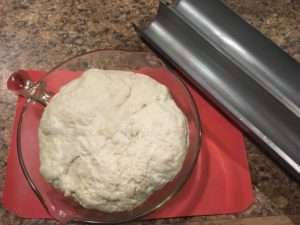 All whole-grain bread contains minerals that include potassium, phosphate, magnesium, and zinc. However, the human body isn’t able to absorb those minerals due to the additional presence of phytic acid. Also called phytate, it is considered an antinutrient because it binds to minerals and reduces your body’s ability to absorb them. The lactic acid acts to lower the pH of sourdough, which reduces the phytate content and allows for easier absorption into the body.
All whole-grain bread contains minerals that include potassium, phosphate, magnesium, and zinc. However, the human body isn’t able to absorb those minerals due to the additional presence of phytic acid. Also called phytate, it is considered an antinutrient because it binds to minerals and reduces your body’s ability to absorb them. The lactic acid acts to lower the pH of sourdough, which reduces the phytate content and allows for easier absorption into the body.
The fermentation process also creates probiotic and prebiotic conditions. Probiotics are beneficial bacteria found in certain foods and supplements, while prebiotics feed the healthy bacteria in your gut. Though the baking process kills off the actual probiotics, the lactic bacteria remains and can help aid in digestion.
Sources: Cooking Light and HealthLine.
How to Start a Sourdough Starter
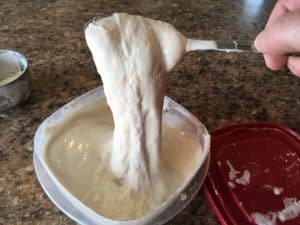 Sourdough starter is made from water and flour that ferments over time, and the flavor matures the longer it is maintained. I started mine from scratch using this process from King Arthur Flour. Basically, it’s a 5-day process that involves two feedings and discards per day. By the end of the process, you should have a live/active starter that is ready to use.
Sourdough starter is made from water and flour that ferments over time, and the flavor matures the longer it is maintained. I started mine from scratch using this process from King Arthur Flour. Basically, it’s a 5-day process that involves two feedings and discards per day. By the end of the process, you should have a live/active starter that is ready to use.
If you know someone who will give you some of their established starter, you can skip this part. If you live local to me, I’d be happy to give you some starter anytime!
How to Store Sourdough Starter
Unless you are planning to use your starter often, it works best to keep it stored in the refrigerator and to feed/use it once per week. In between feeding and use, the sourdough starter needs to be stored in something that doesn’t let it dry out, yet lets gas escape.
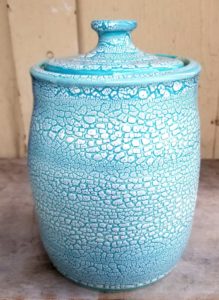
Currently, I store my sourdough starter in the refrigerator in a wide-mouth quart mason jar with a silicone fermentation lid. Ceramic sourdough crocks are also a beautiful and functional option, like these colorful 1-quart beauties made by Mark Campbell Ceramics.
When you are done feeding and using your starter each week, just put about 1/2 cup back into a clean jar with your fermenting lid or your sourdough crock, and refrigerate.
It doesn’t hurt your starter to NOT be refrigerated, but it needs to be fed daily if it’s out of the fridge. People who bake often usually leave theirs out on the counter. I generally use mine only once a week or every other week, so it lives in the fridge.
How to Maintain & Use Sourdough Starter
When it’s time to feed and use your sourdough starter, take it out of the refrigerator and feed it with one scant cup of all-purpose unbleached flour and 1/2 cup lukewarm water. I usually transfer mine from my jar into a glass mixing bowl with a lid, because it is easier to work with and it needs room to bubble and expand after feeding. When it bubbles more than you expect and oozes all over the counter, it’s a mess. Not that I would know anything about that!
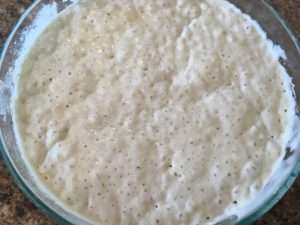 While my starter is feeding in the glass bowl, I usually wash my jar. About 4-6 hours after feeding, I take 1/2 to 1 cup of the starter out of the bowl, put it back in the jar with the lid (or your sourdough crock) and return it to the fridge. I’m consistent with my starter, so I pretty much have it to a point where with one feeding, I end up with 1 cup to use for a recipe and 1/2 to 1 cup to return to the refrigerator. You’ll get familiar with this as you go along.
While my starter is feeding in the glass bowl, I usually wash my jar. About 4-6 hours after feeding, I take 1/2 to 1 cup of the starter out of the bowl, put it back in the jar with the lid (or your sourdough crock) and return it to the fridge. I’m consistent with my starter, so I pretty much have it to a point where with one feeding, I end up with 1 cup to use for a recipe and 1/2 to 1 cup to return to the refrigerator. You’ll get familiar with this as you go along.
If you need more starter for a recipe, you can leave it out of the refrigerator and feed it every 12 hours until you have enough starter for your recipe.
What is Active vs. Discard?
Usually, the recipe will specify if it needs an active starter or starter discard. Most bread recipes will call for active starter, which means it’s been fed 2 times, with most recent feeding happening 4-6 hours ago, and is nice and bubbly. Some other recipes like crackers, biscuits, or waffle batter will call for discard, which means it’s not as bubbly or not at all bubbly because more time has passed since it was fed.
Depending on what you are making, you will wait a few hours or more after feeding and then use. If I’m going to make bread or something else that I really want to get a good rise from, I’ll do at least 2 feedings before making my recipe. That ends up making it a two-day process, because you take it out of the refrigerator and feed it, then feed it again 12 hours later, then use it 4-6 hours after that when it’s nice and active. You want to consider this timing-wise, so you don’t end up with bread that is risen and ready to bake at 2 am.
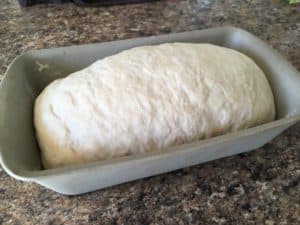 For example, if I were going to make white sourdough bread, I would take my starter out of the refrigerator at 7:00 pm and feed it. I would leave it out on the counter overnight, and I would feed it again around 7:00 am. I would then take the active starter and mix up my bread dough at about 12:00 pm. A few hours later when it had risen properly (exact time depends on your starter and the temperature of your house), I would bake it. It’s a good weekend project, as you can see … I usually take mine out and mess with it on Saturday.
For example, if I were going to make white sourdough bread, I would take my starter out of the refrigerator at 7:00 pm and feed it. I would leave it out on the counter overnight, and I would feed it again around 7:00 am. I would then take the active starter and mix up my bread dough at about 12:00 pm. A few hours later when it had risen properly (exact time depends on your starter and the temperature of your house), I would bake it. It’s a good weekend project, as you can see … I usually take mine out and mess with it on Saturday.
What If You Don’t Want to Bake this Week?
If you don’t want to make something each week, you still have to feed it once a week or it could die. To be honest, I have skipped a week before and it’s done ok! Usually, I do it weekly though. So, if you aren’t going to bake with it after feeding, you would just do the feeding portion and return 1/2 to 1 cup back to the refrigerator, and throw the extra part away. I don’t really ever throw mine away, I always find something to make. (Hint: Waffle batter is a great “lazy” thing to use it in!)
Here is a helpful article that discusses a bit more about the weekly feeding and tips for use.
Ways to Save/Hibernate Sourdough Starter
If you want or need a break from maintaining your sourdough starter, you can freeze it. Once defrosted, it returns to normal after feeding – freezing it doesn’t kill the starter cultures. Actually, I recommend freezing 1/2 cup of your starter so if you mess up your original, you have a backup.
You can also dehydrate your sourdough starter. This is another great way to save a “backup” of your starter for later use or to share with others! I recently dried some of mine, and have it available to share with you by mail if you would like. Just let me know! All I ask is that you cover the cost of postage, which is about $4.00.
Some Helpful Breadmaking Supplies
In the recipes I’m sharing below, you will notice that most of them use Instant Yeast instead of the active dry yeast you may be accustomed to using. I wasn’t able to find it locally in stores, so I buy it in bulk online and store it in the freezer.
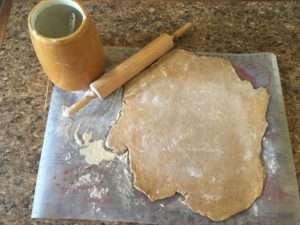 Many of the recipes also have you knead the dough, some for up to 15-20 minutes. The first time I made sourdough bread I did the kneading process by hand. What a workout! After that, I snagged a used breadmaker and use it primarily for the kneading process. You can also use a stand mixer with a dough paddle.
Many of the recipes also have you knead the dough, some for up to 15-20 minutes. The first time I made sourdough bread I did the kneading process by hand. What a workout! After that, I snagged a used breadmaker and use it primarily for the kneading process. You can also use a stand mixer with a dough paddle.
A pastry mat and dough scraper are also useful tools for manipulating your dough as needed per recipes, and for some recipes, you will also need a rolling pin.
I have several of these baking sheets, they work well for baking several of the recipes. They are great for the dough proofing in recipes that are buns, muffins, etc. I put my dough on a greased sheet and then use another sheet upside down on top of it as the lid. This prevents the dough from drying out while it raises.
I also have a couple of stoneware loaf pans like this that I use for the regular bread recipes.
Ways I Have Used My Sourdough Starter
Now, without further ado, here’s what I’ve been most excited to share with you. In order of most to least favorite, here is what we have made with our sourdough starter in her first year with us! Each title links to the recipe we use, and I’m happy to answer any questions you may have!
Sourdough Waffles and Pancakes
Sourdough waffles are our favorite thing to make with our sourdough starter. I gave some starter to my sister recently and told her that if she never makes anything else with it, it’s worth keeping around for the waffles. They are really SO GOOD. I’ve been known to really struggle with waffle makers, but I’ve had a lot of practice using ours in the past year! We actually didn’t care for the sourdough pancakes as much, so when we make this recipe we always do waffles now. They also freeze well, for a short time – which is helpful because the recipe makes a large batch!
Sourdough English Muffins
These are fun to make and so delicious. They freeze well, and we use them primarily for breakfast sandwiches. We usually do an egg and cheese muffin with some of our homemade turkey breakfast sausage.
Sourdough Crumpets
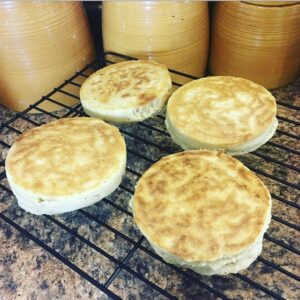 These are super easy to make, with just 1 cup of sourdough starter discard, sugar, salt, and baking soda. The recipe makes 4-5 crumpets, which are delicious toasted and served with cream cheese and homemade jam. I tried making them without rings once, and they didn’t turn out well. You can use a set like this, or wide-mouth mason jar rings also work! If you use mason jar rings, put them lip-side down to start with so when you flip them, the crumpets can be easily pushed out the bottom.
These are super easy to make, with just 1 cup of sourdough starter discard, sugar, salt, and baking soda. The recipe makes 4-5 crumpets, which are delicious toasted and served with cream cheese and homemade jam. I tried making them without rings once, and they didn’t turn out well. You can use a set like this, or wide-mouth mason jar rings also work! If you use mason jar rings, put them lip-side down to start with so when you flip them, the crumpets can be easily pushed out the bottom.
Basic Sourdough Bread
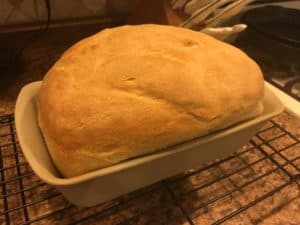 I have made this recipe several times. It makes kind of a weird amount of dough, it’s too much for one loaf of bread but not enough for two loaves. The best luck I’ve had is to use like 3/4 of the dough for a loaf of bread and the other 1/4 for a small French-style loaf. As I mentioned above, I recommend either a breadmaker or a stand mixer with a dough paddle to take care of the kneading process for you.
I have made this recipe several times. It makes kind of a weird amount of dough, it’s too much for one loaf of bread but not enough for two loaves. The best luck I’ve had is to use like 3/4 of the dough for a loaf of bread and the other 1/4 for a small French-style loaf. As I mentioned above, I recommend either a breadmaker or a stand mixer with a dough paddle to take care of the kneading process for you.
Bread Machine Sourdough Bread
This is basically the same recipe as above, but with two size options for a breadmaker and baking instructions. I normally just use the breadmaker for the kneading part, but when I made this bread I also baked it in here. It worked fine!
Rustic Sourdough Bread
 We really like this bread. It makes two pretty large loaves, and we usually eat one and freeze one for later.
We really like this bread. It makes two pretty large loaves, and we usually eat one and freeze one for later.
Sourdough Ciabatta Sandwich Rolls
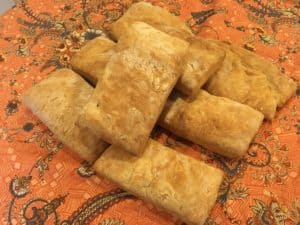 I didn’t have very good luck with this recipe. My rolls came out as hard as rocks. I would try it again because I skipped the spraying with water part and it’s possible I just didn’t do something quite right. We love ciabatta rolls, so I’m going to either have to try this one again or maybe find a different recipe to try.
I didn’t have very good luck with this recipe. My rolls came out as hard as rocks. I would try it again because I skipped the spraying with water part and it’s possible I just didn’t do something quite right. We love ciabatta rolls, so I’m going to either have to try this one again or maybe find a different recipe to try.
Sourdough Pizza Crust
 We just add about 1/2 cup of sourdough starter to our regular pizza crust recipe. It makes it crispier! We pre-bake the crust at 425 degrees for 8-10 minutes before adding toppings and baking for 10-15 more minutes. I use a 12-inch cast-iron skillet, so play with times depending on your oven and pizza pan.
We just add about 1/2 cup of sourdough starter to our regular pizza crust recipe. It makes it crispier! We pre-bake the crust at 425 degrees for 8-10 minutes before adding toppings and baking for 10-15 more minutes. I use a 12-inch cast-iron skillet, so play with times depending on your oven and pizza pan.
Sourdough Meat Pies
 We had some leftover roast beef and made some beef and onion hand pies with sourdough crust. They were really good!
We had some leftover roast beef and made some beef and onion hand pies with sourdough crust. They were really good!
Sourdough Pretzels
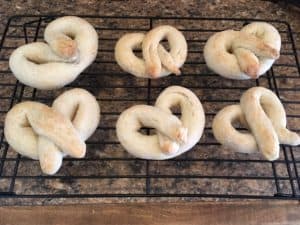 These were easier to make than you would think, and they were tasty.
These were easier to make than you would think, and they were tasty.
Sourdough Crackers
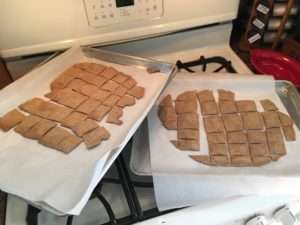 These crackers were one of the first things I made with my sourdough. I probably wouldn’t make them again, as they didn’t stay crispy for more than a day. Lots of people seem to really like this recipe though, I suppose they would be good for a party or something where they would all be eaten right away?
These crackers were one of the first things I made with my sourdough. I probably wouldn’t make them again, as they didn’t stay crispy for more than a day. Lots of people seem to really like this recipe though, I suppose they would be good for a party or something where they would all be eaten right away?
Rustic Sourdough Noodles
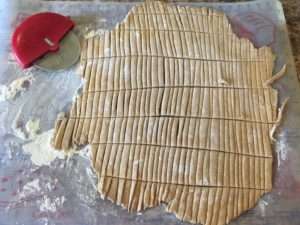 I thought these noodles sounded like fun, but they were kind of time-consuming. I don’t think I rolled them out thin enough, and then when we cooked them they were kind of doughy. They may have been better if I had rolled them out thinner. Regardless, I probably wouldn’t try them again. It made a cool picture, though!
I thought these noodles sounded like fun, but they were kind of time-consuming. I don’t think I rolled them out thin enough, and then when we cooked them they were kind of doughy. They may have been better if I had rolled them out thinner. Regardless, I probably wouldn’t try them again. It made a cool picture, though!
Sourdough Sandwich Biscuits
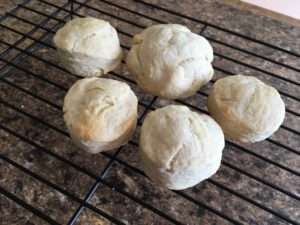 This is another one of the recipes I made early on in my sourdough adventures. I didn’t really care for them at the time, but now that I know more about what I’m doing I may try them again.
This is another one of the recipes I made early on in my sourdough adventures. I didn’t really care for them at the time, but now that I know more about what I’m doing I may try them again.
Can I Help you Get Started?
I’m not an expert by any means, but I would be happy to help answer any questions you may have about getting started with your own sourdough starter. I’ve learned a lot about breadmaking in the past year, and I’m still learning!


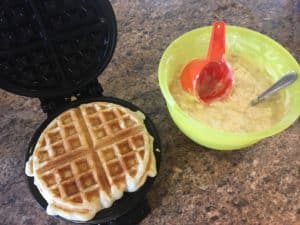
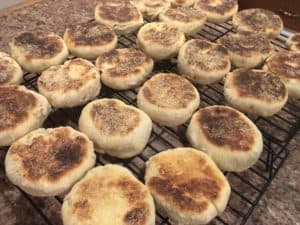

That looks yummy. Do you have a lower carb version? Have a fantastic Friday!
Hi Cynthia,
Thanks for your question! I know you can make a gluten-free sourdough starter by using gluten-free flour, but I’m not sure about any of the other alternative flours. I do know that the fermentation of the sourdough process offers probiotic benefits and makes the bread easier to digest than non-sourdough bread. 🙂
– Darcy